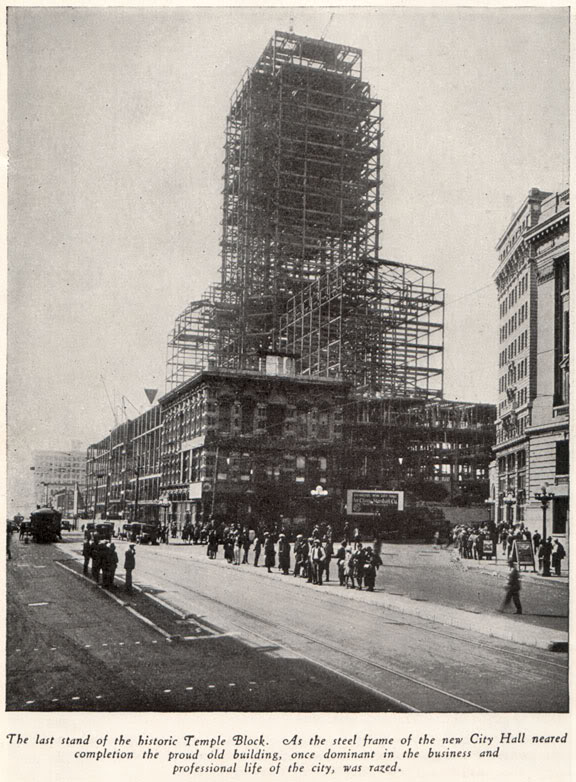Temple Square – the heart of the city, 1885 – at the intersection of Temple, Main and Spring Streets:

USC Digital Archive.
Temple Square, 1927. The new City Hall looms over the doomed Temple Block:

Photo from La Reina - Los Angeles in Three Centuries, Published by Security Trust & Savings Bank, Los Angeles, 1929.
Temple and Main Streets, today:

Photo by J Scott Shannon.
The Temple Block was the ornate 3-storey brick structure in the older photos. It was the hub of civil life in Los Angeles during the 1870s-1880s. As we face the Temple Block, Main Street runs to the left, and Spring Street emerges at a diagonal angle to the right. Temple Street runs from left to right in the upper photo, but it can't be seen because it's obscured by the Downey Block at far right. (Here is Temple Street heading west from Temple Square.)
Spring Street was realigned when construction of the new City Hall began in early 1927. Spring now runs parallel to Main, and intersects with Temple where the large skyscraper at right is now located.
What strikes me the most when I compare these images is how the city center of old Los Angeles was a vibrant place, alive with people and commerce, while today's sterile Civic Center is almost exclusively a home for government, and where the populace is only a transitory visitor.
It's difficult to imagine this extensive a change taking place within a period of only two normal human lifespans, isn't it? Were a citizen of 19th century Los Angeles to suddenly find themself transported to today's Temple and Main, the place would no doubt be completely alien to them. Like another world entirely...
4 comments:
Great pictures. Photos like these need to be kept in circulation.
The Downey Block was actually a marketplace for Native American slaves in the 1850s and 1860s, where Native Americans arrested for drunkenness and begging were auctioned off for one week of labor for one to three dollars.
@Caitlin: That statement cannot be true. The Downey Block wasn't even built until 1869, years after slavery of any kind was abolished by the 13th amendment.
Caitlin and Scott are both right. I believe Caitlin's comment was based on this: http://tumblr.lareviewofbooks.org/post/29983080210/then-and-now-the-downey-block-of-downtown-laowney. Wendy Cheng was a bit misleading in that she identifies the Downey Block, rather than the location of the Downey Block, as the Indian slave market. John Temple, I think, had a small store there at the earlier time, across from his Temple Block buildings.
As the Federal Courthouse, which currently occupies the location, is to be demolished next year, a memorial park at this site is literally the least that can be done now.
Post a Comment
Note: Only a member of this blog may post a comment.